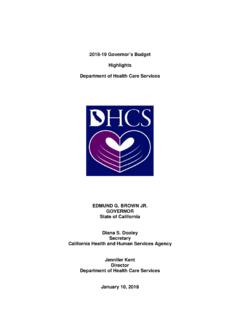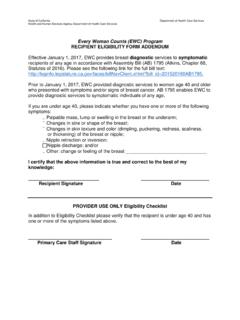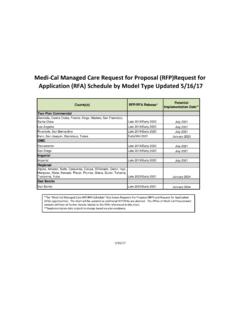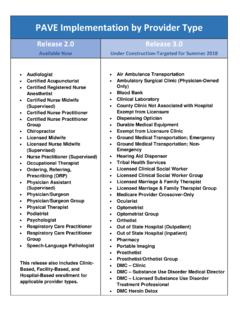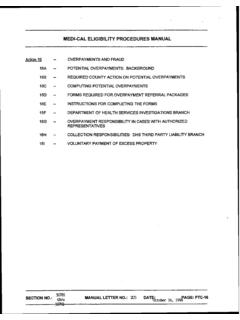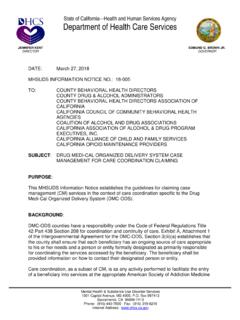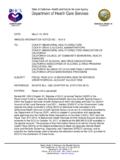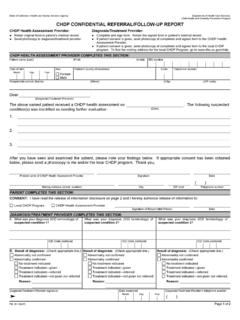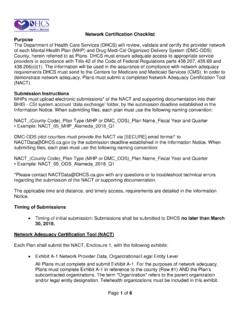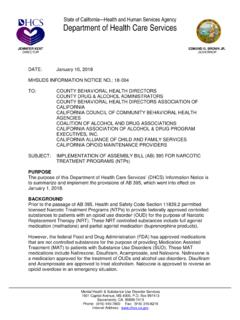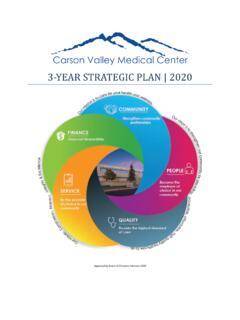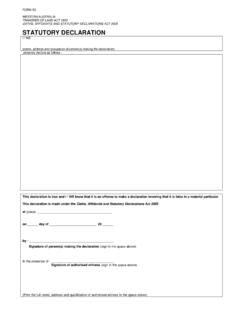Transcription of Whole Person Care Program - California
1 Whole Person care Program Medi-Cal 2020 Waiver Initiative California Department of Health care Services November 2016 1 Program Overview 2 Whole Person care Overview 3 Overarching goal for Whole Person care (WPC) Coordination of health, behavioral health, and social services Comprehensive coordinated care for the beneficiary resultingin better health outcomes WPC Pilot entities collaboratively to: Identify target populations Share data between systems Coordinate care real time Evaluate individual and population progressPhysical health Social services Behavioral health Goals and Strategies Increase, improve, and achieve: Integration among county agencies, health plans, providers, and other participating entities Coordination and appropriate access to care Access to housing and supportive services Health outcomes for the WPC population Data collection and sharing among local entities Targeted quality and administrative improvement benchmarks Infrastructure that will ensure local collaboration over thelong term4 Reduce.
2 Inappropriate emergency department and inpatient utilization WPC by Numbers 5 year Program $ total federal funds $300M annual available 2 application rounds 18 applicants for Round 1 5 Funding No single WPC pilot will be awarded more than 30% of total available funding unless additional funds are available after all initial awards are made Funding is based on semi-annual reporting of activities/interventions Non-federal share provided via intergovernmental transfer (IGT), matched with federal Medicaid funding 6 Lead Entities Lead Entities County A city and county A health or hospital authority A designated public hospital A district/municipal publichospital A federally recognized tribe A tribal health Program under aPublic Law 93-638 contract withthe federal Indian Health Services A consortium of any of the aboveentities Submits Letter of Intent and applicationServes as the contact point for DHCSC oordinates WPC pilotCollaborates with participating entitiesLead Entity Responsibilities 7 Participating Entities 8 Participating Entities (1) Medi-Cal managedcare health plan (1) Health servicesagency/department (1) Specialty mental healthagency/department (1) Publicagency/department (2)
3 Community partners Participating Entity Responsibilities Collaborates with the leadentity to design andimplement the WPC pilot Provides letters ofparticipation Contributes to datasharing/reporting Relationships Between Entities WPC Goals for Participating Entities Increase integration among county agencies, health plans, providers, and otherentities within the county that serve high-risk, high-utilizing beneficiaries Develop infrastructure to ensure collaboration among the participating entitiesover the long termRequirements Lead entities indicate in the application who the participating entities will be. DHCS encourages a collaborative approach. Only one Medi-Cal managed care plan is required to participate, but DHCS encourages including multiple plans.
4 Medi-Cal managed care plan participation must include the plan s entire network( , where delegation of risk has occurred to an entity in the plan s network). Specific exclusions and exceptions may be considered on a case-by-case basis. Lead Entities cannot also be one of the two required community Target Populations Identifying target population(s) WPC pilots identify high-risk, high-utilizing Medi-Cal beneficiaries in their geographic area. Pilots work with participating entities to determine the best target population(s) and areas population(s) may include, but are not limited to, individuals: with repeated incidents of avoidable emergency use, hospital admissions, or nursing facilityplacement; with two or more chronic conditions; with mental health and/or substance use disorders; who are currently experiencing homelessness; and/or who are at risk of homelessness, including individuals who will experience homelessnessupon release from institutions ( , hospital, skilled nursing facility, rehabilitation facility,jail/prison, etc.)
5 May also include the following populations with certain caveats: Individuals not enrolled in Medi-Cal, but federal funding is not available for them Dual-eligible beneficiaries, but must coordinate with the Coordinated care Initiative whereapplicable10 Program Structure 11 Administrative Infrastructure Description Builds the programmatic supports necessary to plan, build andrun the pilotExamples Core Program development and support Staffing IT infrastructure Program governance Training Ongoing data collection Marketing materials12 Delivery Infrastructure Description Supports the non-administrative infrastructure needed to implement the pilot Examples Advanced medical home Mobile street team infrastructure Community paramedicine team Community resource database IT workgroup care management tracking and reporting portal 13 Payment Mechanisms 14 PMPM Bundle One or more services and/oractivities that would bedelivered as a set value to adefined population Examples.
6 Comprehensivecomplex care management,housing support services,mobile outreach andengagement bundle, long-term care diversion bundle FFS Items Single per-encounterpayments for a discreteservice Examples: Mobile clinic visit,housing transition services,medical respite,transportation, soberingcenter, care coordination Performance Measures Objective To assess the success of the Pilot in achieving theWPC goals and strategiesReporting requirements All WPC Pilots must report initial baseline andsubsequent year data on universal and variantmetrics as outlined in Attachment MM of theSpecial Terms & Conditions (STCs)15 Performance Measures Health Outcomes Universal Metrics Ambulatory care - Emergency Department Visits Inpatient Utilization - General Hospital/Acute care Follow-up After Hospitalization for Mental Illness Initiation and Engagement of Alcohol and Other Drug Dependence Treatment Health Outcomes Variant Metrics, as applicable 30 day All Cause Readmissions Decrease Jail Recidivism Overall Beneficiary Health Controlling Blood Pressure HbA1c Poor Control <8% Depression Remission at Twelve Months Adult Major Depression Disorder (MDD).
7 Suicide Risk AssessmentHousing Variant Metrics, as applicable Percent of homeless who are permanently housed for greater than 6 months Percent of homeless receiving housing services in PY that were referred for housing services Percent of homeless referred for supportive housing who receive supportive housingPilot-identified Pay for Outcome metrics, other than required universal and variant metrics 16 Summary of First Round Applications 17 First Round Applications Counties with < 1,000 sq. mi. (7) Alameda Contra Costa Napa Orange San Francisco San Mateo Solano Counties between 1,001 3,000 sq. mi. (4) Santa Clara San Joaquin Placer Ventura Los Angeles Monterey San Diego Shasta Counties between 3,001 5,000 sq. mi. (4) 18 Counties with > 5,000 sq.
8 Mi. (3) Kern Riverside Pilot Size Larger: Over 100,000 Los Angeles Large: Between 10,000 and 100,000 Alameda Contra Costa Riverside Santa Clara San Francisco Medium: Between 1,000 and 5,000 Kern Orange San Diego San Joaquin San MateoVentura 19 Small: Between 250 and 800 Monterey Napa Placer Shasta Solano Target Population Selection 20 Target Population Criteria # of Pilots that Selected this Target Population utilizers with repeated incidents of avoidable EDuse, hospital admissions or nursing facility placement15 Pilots 2. High utilizers with two or more chronic conditions3 Pilots 3. Individuals with mental health and/or substance use8 Pilots disorder conditions4. Individuals who are homeless/at-risk for homelessness14 Pilots 5. Individuals recently released from institutions ( ,7 Pilots hospital, county jail, IMD, skilled nursing facility, etc.)
9 care Coordination Strategies Navigation infrastructure (13 Pilots) Standard Assessment Tool (9 Pilots) Data sharing systems (9 Pilots) Social determinants strategies (7 Pilots) Data-driven algorithms (4 Pilots) Prioritization of highest needs if on a waiting list (3 Pilots) 21 Data and Information Sharing Expansion of existing data sharing framework (18 Pilots) Bi-directional data sharing with MCPs (18 Pilots) Health Information Exchange (12 Pilots) Patient population software (11 Pilots) Data warehouse (9 Pilots) Query-based real-time data (7 Pilots) Case management software (7 Pilots) Real-time data sharing (6 Pilots) New data sharing systems (3 Pilots) 22 Services and Interventions care Management (15 Pilots) Wellness and Education (9 Pilots) Housing Services (11 Pilots) Flexible Housing Pool (17 Pilots) Post-Incarceration Services (4 Pilots) Mental Health (6 Pilots) Mobile Services (4 Pilots) Respite Services (4 Pilots) Sobering Centers (4 Pilots) 23 Resources 24 the Whole Person care webpage: questions/sign up for the listserv.
